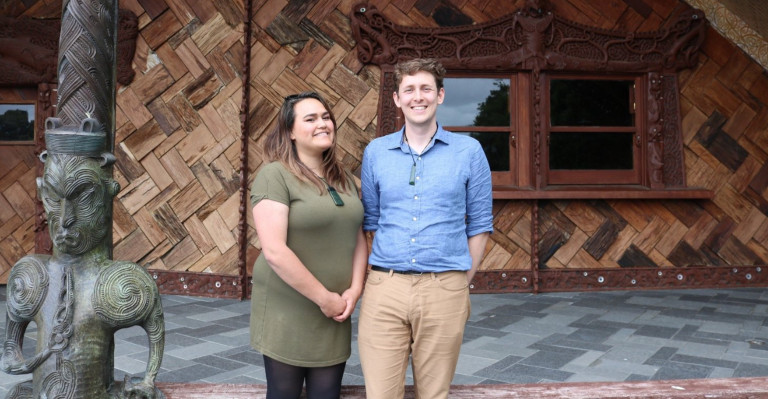Early career researchers take the lead
22 March 2023 | Read time: 6 minutes

The Science for Technological Innovation National Science Challenge is funding talented young researchers up to $200,000 per project as part of our ‘Early Career Researcher Bolt-on’ funding initiative.
“We’re taking the opportunity to support and extend some of the exciting young researchers who have been involved in some of our other projects.” said Sally Davenport, Director of SfTI.
“Our bolt-on projects will remain linked to our large scale Spearhead projects by utilising the skills of young researchers to further the research in one key area. It’s been thrilling to see the depth of talent and potential coming through and the big ideas that we believe will connect with a variety of different communities.”
“Our bolt-on projects will remain linked to our large scale Spearhead projects by utilising the skills of young researchers to further the research in one key area. It’s been thrilling to see the depth of talent and potential coming through and the big ideas that we believe will connect with a variety of different communities.”
The projects include co-designing simple and cheap new insulin pumps with nurses and Māori communities, building immersive tātai arorangi/astronomical explanations about Matariki for smart phones, teaching engineering students to build intelligent robots, and developing a shape shifting device to keep pot plants healthy.
SfTI’s ‘Early Career Researcher Bolt-On projects’ are designed to enable researchers who are either currently studying towards higher level degrees or just beginning their careers to design, lead and deliver on a project that enhances the capacity of the team members.
Each project will last 12-18 months, ending as the National Science Challenges draw to a close in June 2024. The projects are described below.
One of the many challenges people with diabetes face is invasive, expensive, difficult-to-use technology, which means they have less control of their condition. From a Te Ao Māori perspective, the body is considered tapu and blood is valued as sacred. This can also lead to hesitation in accepting external technology.
“We’re focusing on giving people with diabetes and nurses input on the design of externally worn diabetes technology, in order for people with diabetes to manage it on their own terms,” said Dr Grace Walker (Ngati Kahungunu, Ngāruahine) who is co-leading this project.
This project builds on the SfTI funded work on creating new needle free sensing and insulin delivery technology.
Project: Matariki Hunga nui: Mixed Reality Experience
After building a 3D replica of Te Rau Aroha Marae in Bluff that allows kanohi ki te kanohi interaction with kaumatua, early career researchers from the Ātea project are extending this work. They are building a mobile phone-compatible Mixed Reality (MR) based tātai arorangi/Māori astronomy experience with immersive content about Matariki.
“With the recent introduction of the Matariki public holiday, there has been an increasing interest around the country in learning about the science and the story of Matariki. The aim is for people to learn from key kaikōrero by either watching on regular mobile phone screens or using a virtual reality headset to experience Matariki in mixed reality,” said Kris Tong, one of the co-leaders of the project.
SfTI is funding a state-of-the-art research programme in intelligent robotics, supported by current PhD students across different universities. The selected students will work on computational models that allow robots to autonomously navigate unexpected conditions and use multiple ‘fingers’ to grasp and manipulate objects. This way of applying learning techniques to robotics systems is still in its infancy and the project aims to develop a collaborative open-source platform that will place these researchers among global leaders in the industry.
“How do you teach a robot? You teach an engineering student first. This new pipeline for early career researchers will help them to obtain skills in robotics and automation that are in demand,” said Dr Henry Williams, one of the mentors involved in the project.
This project builds on the SfTI funded project focusing on adaptive learning robots to complement the human workforce.
Project: Shape-shifting devices for plant condition monitoring and control
A shape-shifting device in development by PhD student Heiana Agnieray will constantly monitor the healthy growth and wellbeing of potted plants. She will use 4D printing technology to create a simple, shape-shifting conditioning monitoring device with a remote-controlled sponge that users will be able to programme to either provide or extract water in the pot. This project could also lead to the development of a multi-functional device with sensors that are adapted to detect soil pathogens.
“The idea of a material changing its shape without being pushed, nudged, turned or externally controlled comes from 3D printing. The point-by-point processing allows control over a material’s composition and internal structures and the embedding of external devices,” said Heinana Agnieray.
This project will take developments from a SfTI funded project on shape-shifting antennae and adapt them to monitor plants.